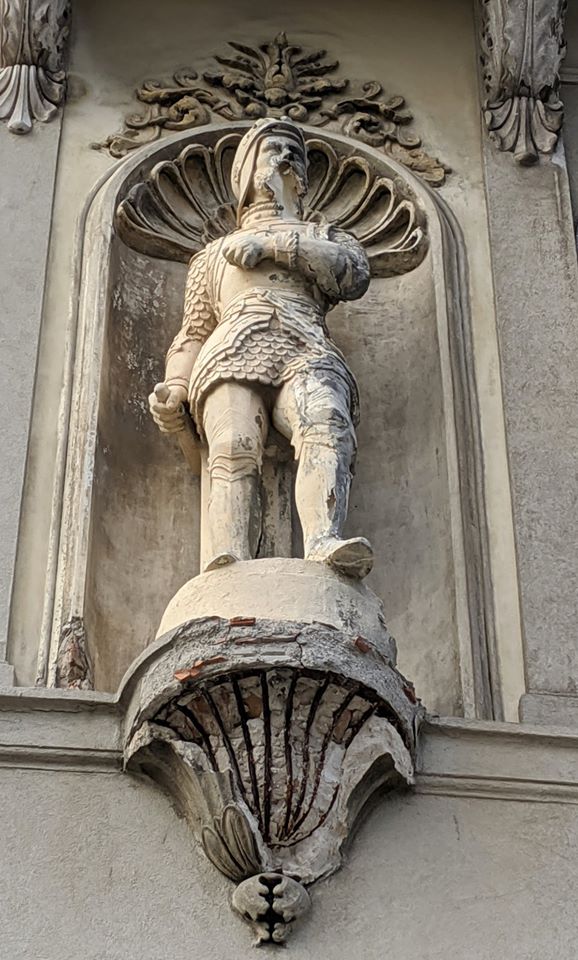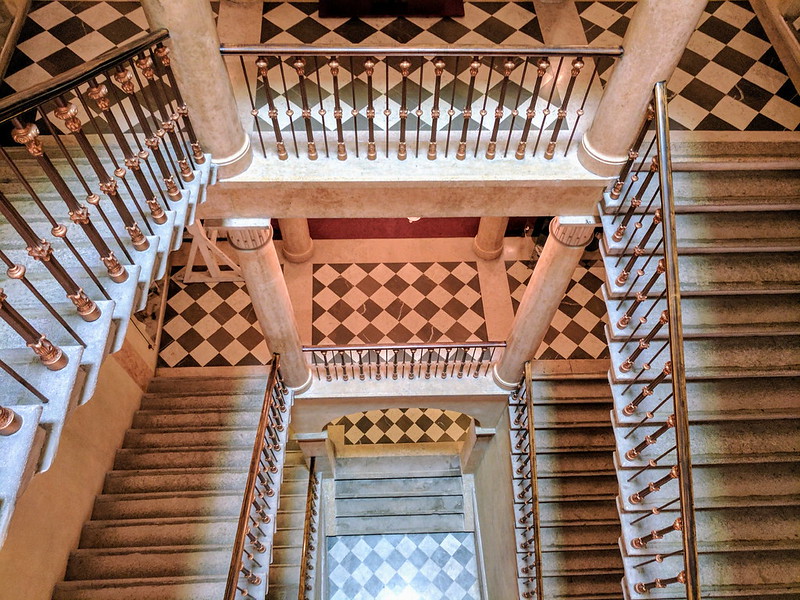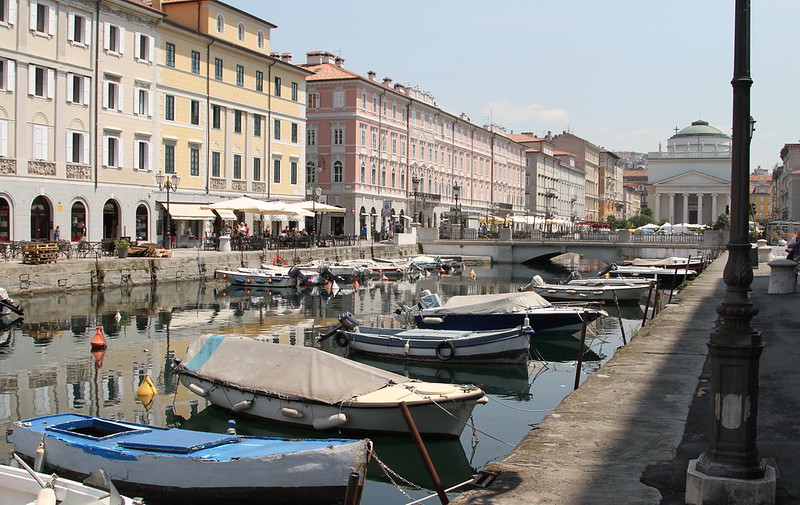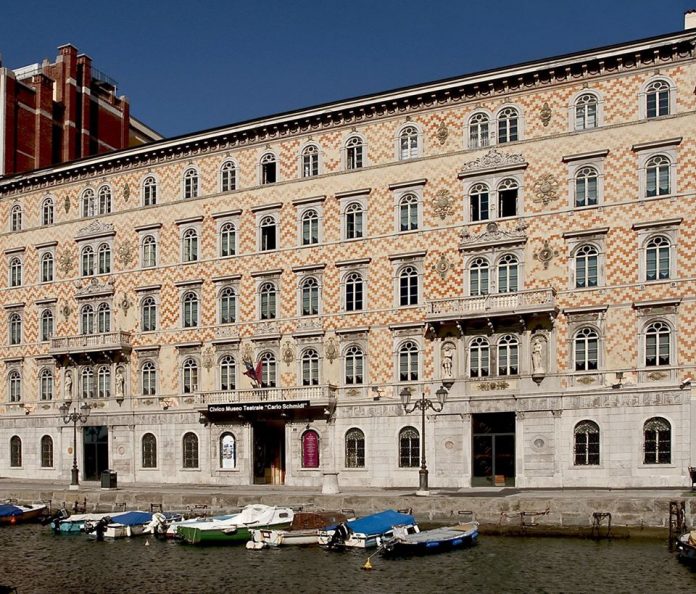by InTrieste
The Palazzo Gopcevich can be seen on the north side of the Canal Grande, next to the recently renovated Generali HQ (red building on the Rive).
Its exquisite facade is best seen when it catches the late afternoon sun. The old palace houses a permanent collection of theatrical dress and musical instruments on the 2nd & 3rd floors.
On the ground floor (left side as you look at the building) they put on rotating exhibitions of various kinds. There are also free concerts, with limited seating, from time to time on the ground floor (inside to the right).


History
Designed by Giovanni Berlam in 1850, at the initiative of Spiridione Gopcevich, the Palazzo Gopcevich reflects the taste and culture of Romanticism. The 4 statues at the entrance of the palace – one of which was the quiz question – represent the heroes of the Battle of Kosovo in 1389.
The historical musical collection was started in 1872 by Carlo Schmidl. He had been a young apprentice and copyist in the musical store of the firm Maria Vedova Vicentini. The Museum started with the far-sighted donation of his Historical Musical Collection, the aim being to document the stage and musical life of Trieste from the 18th century to the present day.
Posters, fliers, photos, engravings, medals, paintings, musical instruments, various objects, archives and manuscripts built up a “theater of memory”, the collections having been constantly increased throughout the last century.
From 1924 to 1991, the Museum was hosted in the Teatro Comunale Giuseppe Verdi. In 1992 it was provisionally moved to Palazzo Morpurgo in via Imbriani, and later bought and transformed into a museum by the Municipality of Trieste. The grand opening on December 16, 2006 was made possible through the generous donation of Fulvia and Fulvio Costantinides, who wanted to honor the memory of Giorgio Costantinides.

The Museum Collections
The floors and ceilings of the 1st floor are richly decorated. It is dedicated to the history of theatres, actors, and singers in Trieste for over 2 centuries. One section displays musical instruments from all over the world, and the workshop of a Luther from Trieste, Francesco Zapelli. Other musical instruments (mechanical ones in particular) are exhibited on the 2nd floor. Here there are rooms dedicated to the memory of Giorgio Strehler (whose personal archive is preserved in the Museum’s library) and to the documentation and reference services. Visitors and researchers can mingle among the rich Museum’s heritage, which is still being increased on a daily basis.
The collection of paintings is outstanding and includes mostly portraits of actors and musicians by painters such as Gino Parin, Umberto Veruda, Arturo Rietti and Carlo Wostry. The paintings are accompanied by engravings portraying artists and theatrical places, as well as by sketches of scenes and costumes for operas, operettas and dramas that were staged in theaters around Trieste.
One can also see a wide variety of mementos and keepsakes once belonging to artists; stage costumes and jewelery, the most significant ones owned by the great Triestina mezzo-soprano, Fedora Barbieri; puppets and marionettes. The medal cabinet hosts about 1000 pieces, among which there are examples dating back to the 18th century. The collections include also a Photo Library of more than 50,000 pictures, and around 30,000 autograph of such notables as Rossini, Verdi, Boito, Puccini, Adelaide Ristori and Serge Lifar.

Library, Archives, & Multimedia Resource Centre
The Museum collections of books and archives have an international relevance because of their size and number. The library, with the wealth of more than 100,000 books mainly about music, theatre and cinema, hosts a section of opera librettos, one of musical sheets and another with periodicals.
The archives of more than 4000 files include collections of documents once belonging to: Carlo Schmidl, Teatro Stabile del Friuli Venezia Giulia (1952-2000), Teatro Verdi (1798-2000), Premio Musicale “Città di Trieste”, Fondazione Istituto d’Arte Drammatica (I.D.A.D.) of Trieste, Giorgio Strehler, Giulio Viozzi, Dario Daris and John Gualiani. Theatres and artists’ lives and activity are documented by the collection of about 90,000 posters and programs by the printed database, and by more than 600 archival boxes with press reviews and other documents.
The Multimedia Resource Centre, founded in 1985, encompasses more than 20,000 records, including the bequest of physician Riccardo Gmeiner (1905-1984), to whom the section is dedicated, and pre-existing collections of musical recordings, as well as subsequent acquisitions.





























